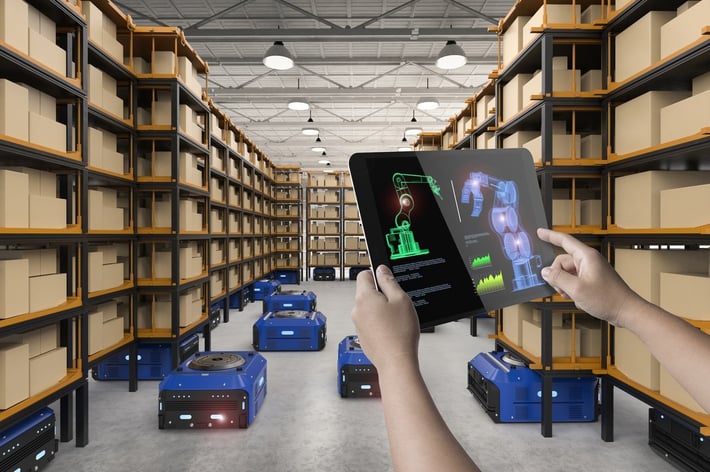
Over ten years ago, Kiva Systems forever changed the warehouse landscape by introducing their flagship product, the Kiva robot, as a solution to reduce inefficient footsteps. Snapped up by Amazon in 2012, the void left by Kiva has been quickly filled by a dozen cutting-edge companies offering innovative, collaborative robots to work alongside warehouse employees.
Most of these solutions offer common benefits. Promises of 2-3x productivity gains are standard fare. Advances in sensor technology and onboard processing allow real-time environment mapping, feeding intelligent data to the robots as they swarm throughout the warehouse, navigating safely and efficiently. User-friendly interfaces allow temp employees to get up to speed in minutes.
Which solution is right for you? Here are ten factors to consider when deciding between robots to boost warehouse efficiencies:
1. Robot Capacity
For e-commerce operations where speedy order fulfillment is paramount, a large number of smaller robots is preferable over a smaller number of machines with high-capacity shelves. However, if you are batching orders to pick a quantity of each item, consider an option that can be configured to move large bins or shelves.
2. Infrastructure Requirements
Do you have an existing operation already in place? Then you’ll probably want a solution that will not require massive changes such as relocating or completely ripping out all of your racking. The Kiva solution was remarkably innovative, and similar solutions are still highly effective, but they require changing your entire facility around that system. Most operations do not have the luxury of starting from scratch, so look to vendors that can fit into and utilize your existing infrastructure.
3. WMS Integration
If you want a quick robotics install without the headaches of integrating with your warehouse management system, most vendors can configure their fleet to shuttle back and forth between predefined locations. Users simply tap the screen to direct the robot to a specific pick zone or packing location. However, to truly leverage the artificial intelligence built into these platforms, a full WMS integration allows orders to be optimally sorted, grouped and assigned to robots and pickers most efficiently.
4. Meet vs. Follow
Some robotic solutions will send the robots directly to the pick location, showing pick information onscreen. After the pick is scanned and confirmed, the bot will glide away to
5. Aisle Constraints
Consider your aisle width when choosing a vendor. For sites with extremely narrow aisles, it may be necessary for the robot to pick up/drop off mobile “
6. User Interface
Most commonly, the robotic solution will include a large integrated touchscreen display, allowing the user to interact easily. Pick information, including an optional photo of the actual pick item, is clearly displayed, and the RF scanner is typically built into the same unit. New employees quickly learn the user-friendly interface and can pick at
7. Platform Intelligence
Carefully consider the features of the software platform, the vendor’s system that sits between the robots and the WMS. Many vendors know robotics, but do they know warehousing?
- How are exceptions and priority orders handled?
- How does it sort, batch and assign tasks?
- Can it give you feedback to help optimize slotting?
- Can it track user performance and “gamify” picking, giving employees instant KPI feedback to motivate and make picking more fun?
8. Finance Model
Until recently, the cost of advanced robotics has been prohibitively expensive; even the most basic solution costs tens of thousands of dollars per robot, and the rate of adoption at warehouses has been slow. Now, however, many vendors have begun offering a leasing option, with a “robot as a service” model. For 3PL contract operations, this has dramatically lowered the barriers to adoption.
9. Vendor Experience
Finally, find out how much experience the vendor has – how many customers do they have, and how many robots are deployed? Can they handle 24/7 support and scaling across your network? Are there reference customers you can talk to or a showcase warehouse you can visit? Warehouse collaborative robotics is a very new field, so don’t let the young age of a company scare you away – these companies have some very impressive solutions, but don’t be afraid to ask tough questions either.
Properly chosen, an automated solution can drastically reduce wasted footsteps, allowing your workforce to focus on more meaningful work. There is no need for your employees to be walking 10-15 unproductive miles each day – let a robot do it!
10. Flexibility
How well does a vendor’s solution adapt to your current operations vs. requiring you to change around them? Does a vendor’s solution offer the flexibility to support multiple use cases across different types of facilities and industries? Can it be reconfigured for different picking strategies, for putaway, or for interleaving? Or is it more of a “one-size-fits-all” solution? As a 3PL it is vital to find automation partners that can grow, scale, adapt and evolve with you.
To Sum It Up
If you are in the beginning stages of implementing robots in your supply chain or this is the first opportunity you have thought about using a higher level of automation – this list can certainly get you started in the right direction to ask the right questions of your 3PL.
We partnered with



